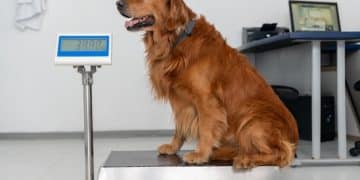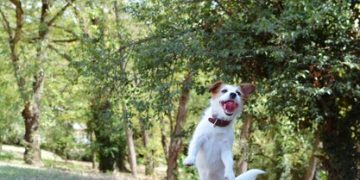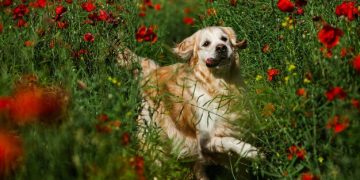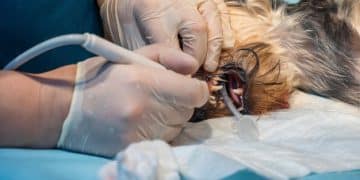Is Your Pet Overweight? A Step-by-Step Guide for US Pet Owners
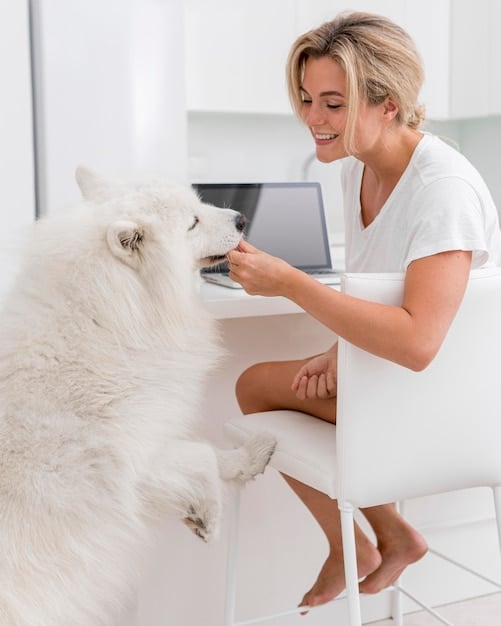
Is your pet overweight? This comprehensive guide provides a step-by-step approach to healthy weight management for your beloved companion, covering everything from identifying obesity to creating a balanced diet and exercise plan, ensuring a happier and healthier life for your pet.
Is your furry friend looking a little rounder than usual? You’re not alone. Is Your Pet Overweight? A Step-by-Step Guide to Healthy Weight Management is crucial for their long-term health and happiness. Let’s explore how to identify weight issues and get them back on track.
Understanding Pet Obesity
Pet obesity is a growing concern in the United States, affecting millions of dogs and cats. Just like in humans, carrying extra weight can lead to a host of health problems for your beloved companions. Recognizing the signs of obesity is the first step in helping your pet live a longer, healthier life.
But what exactly constitutes pet obesity, and how does it impact their well-being? Let’s delve deeper into the definition, prevalence, and consequences of this widespread issue.
Defining Pet Obesity
Pet obesity is generally defined as being 15-20% over their ideal weight. However, determining what an “ideal weight” is can be tricky, as it varies depending on breed, age, and overall body condition. A lean pet should have a visible waistline and you should be able to feel their ribs easily without pressing hard.
Prevalence in the US
Studies show that a significant percentage of pets in the US are overweight or obese. This number continues to rise, largely due to factors like overfeeding, lack of exercise, and readily available, high-calorie pet food. It’s a widespread issue that warrants attention and proactive measures.
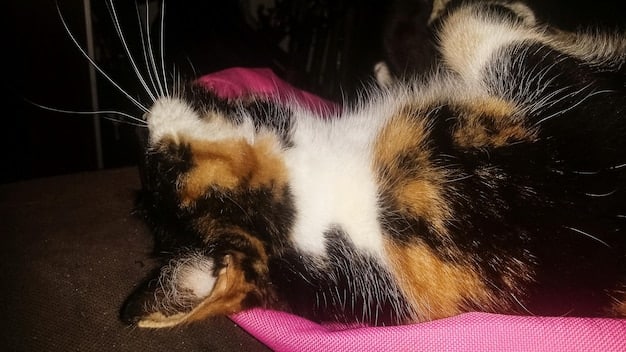
Understanding the health risks associated with pet obesity is paramount. Being overweight can significantly shorten a pet’s lifespan and reduce their quality of life. Here are some of the key health issues linked to pet obesity:
- Diabetes: Excess weight can lead to insulin resistance and type 2 diabetes, especially in cats.
- Arthritis: Extra weight puts added stress on joints, leading to pain and reduced mobility.
- Heart Disease: Obesity can contribute to high blood pressure and other cardiovascular problems.
- Respiratory Issues: Overweight pets often have difficulty breathing, especially during exercise.
Recognizing pet obesity as a serious health concern is the first step toward proactive weight management. By understanding the risks and taking appropriate action, owners can significantly improve their pets’ well-being and longevity.
Assessing Your Pet’s Weight: A Hands-On Approach
Determining if your pet is overweight requires more than just a visual assessment. A hands-on approach, combined with regular monitoring, can provide a more accurate picture of their overall body condition. This involves learning how to properly assess their body condition score (BCS) and frequently weighing them to keep track of any changes.
Here’s a detailed guide on how to assess your pet’s weight effectively:
Body Condition Score (BCS)
The BCS is a standardized system vets use to evaluate a pet’s body fat and muscle mass. It typically ranges from 1 to 9, with 1 being emaciated and 9 being severely obese. Aim for a BCS of 4 or 5, which indicates an ideal weight.
How to Perform a BCS Assessment:
- Rib Check: Gently run your hands along your pet’s ribcage. You should be able to feel the ribs easily, with only a slight layer of fat covering them. If you have to press hard to feel the ribs, your pet is likely overweight.
- Waistline Observation: Stand above your pet and look down at their body. A healthy pet should have a visible waistline. If their body is straight from the ribs to the hips, they may be carrying excess weight.
- Abdominal Tuck: From the side, observe the line of your pet’s abdomen. It should tuck upwards from the ribcage to the hips. If the abdomen hangs down or is parallel to the ground, your pet is likely overweight.
Weighing Your Pet Regularly
Regularly weighing your pet can provide valuable insights into their weight management progress. Use a pet scale or your own bathroom scale to monitor their weight. Record the measurements and look for any significant changes over time. Consistent weight monitoring can help you catch weight gain early and make necessary adjustments to their diet and exercise routine.
- Use a Consistent Scale: To ensure accuracy, use the same scale each time you weigh your pet.
- Weigh at the Same Time of Day: Weight can fluctuate throughout the day, so weigh your pet at the same time for consistent readings.
- Keep Records: Track your pet’s weight over time to identify trends and adjust their weight management plan accordingly.
By combining regular BCS assessments with consistent weight monitoring, you can gain a comprehensive understanding of your pet’s weight status and take proactive steps to ensure their health and well-being.
Calculating Your Pet’s Caloric Needs
Understanding your pet’s unique caloric requirements is crucial for effective weight management. These needs vary based on several factors, including age, breed, activity level, and overall health. Calculating these requirements accurately will enable you to create a meal plan that supports healthy weight loss or maintenance.
Let’s explore the essential factors to consider and some helpful formulas:
Factors Influencing Caloric Needs
- Age: Puppies and kittens require more calories for growth, while senior pets often need fewer calories due to decreased activity.
- Breed: Some breeds are naturally more active and have higher metabolisms than others.
- Activity Level: Active pets burn more calories than sedentary ones. Adjust caloric intake based on their daily exercise routine.
- Health Conditions: Certain health conditions, such as diabetes or kidney disease, can affect caloric needs. Consult with your vet for specific recommendations.
Calculating Resting Energy Requirement (RER)
The Resting Energy Requirement (RER) estimates the number of calories a pet needs at rest. This is the baseline for calculating their daily caloric needs. The formula for RER is:
RER = (Body weight in kilograms ^0.75) x 70
First convert your pet’s weight from pounds to kilograms by dividing by 2.2. For example, a 22-pound dog weighs 10 kilograms.
Then, calculate the RER: (10^0.75) x 70 ≈ 395 calories
Adjusting for Activity and Life Stage
Once you’ve calculated the RER, you’ll need to adjust it based on your pet’s activity level and life stage. Multiply the RER by the appropriate factor:
- Inactive/obese-prone: RER x 1.0
- Normal activity: RER x 1.4
- Active: RER x 1.6 – 2.0
- Growing puppies/kittens: RER x 2.0 – 3.0
Using our example of a normally active dog, the daily caloric need would be 395 x 1.4 = 553 calories.
Remember that these calculations are estimates. Monitor your pet’s weight and body condition regularly and adjust their caloric intake as needed to maintain a healthy weight. Consulting with your vet is always recommended for personalized guidance.
Creating a Balanced Diet Plan
Once you’ve determined your pet’s daily caloric needs, the next step is to create a balanced diet plan that supports their weight management goals. This involves selecting the right type of food, carefully measuring portions, and understanding ingredient labels. A well-structured diet plan can make a significant difference in your pet’s weight and overall health.
Here’s how to develop an effective and balanced diet plan:
Choosing the Right Pet Food
Select a high-quality pet food that is appropriate for your pet’s life stage and health condition. Look for options that are rich in protein, moderate in fat, and low in carbohydrates.
Understanding Ingredient Labels
Pay close attention to the ingredient list. The first few ingredients listed make up the majority of the food. Look for named meat sources (e.g., chicken, beef) as the primary ingredients.
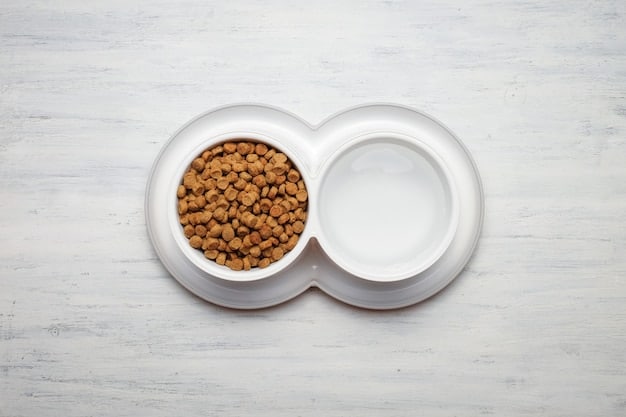
Portion control is critical for weight management. Use a measuring cup to ensure you’re feeding the correct amount of food. Divide the daily caloric needs into multiple meals to help keep your pet feeling full and satisfied.
- Use a Measuring Cup: Avoid estimating portions, as this can lead to overfeeding.
- Divide Meals Strategically: Offer multiple smaller meals throughout the day to help stabilize blood sugar levels and prevent overeating.
- Avoid Free-Feeding: Leaving food out all day can encourage overeating. Stick to a structured feeding schedule.
Remember, every pet is unique. Monitor your pet’s weight and body condition closely and adjust their diet plan as needed. Regular check-ups with your veterinarian are essential to ensure your pet’s nutritional needs are being met.
Incorporating Exercise into Your Pet’s Routine
Exercise is a vital component of any weight management plan for pets. Regular physical activity not only helps burn calories but also improves cardiovascular health, muscle tone, and overall well-being. Incorporating exercise into your pet’s daily routine can be fun and rewarding for both of you.
Here are some effective strategies for adding more activity to your pet’s day:
Choosing the Right Activities
Select activities that are appropriate for your pet’s breed, age, and physical condition. Start slowly and gradually increase the intensity and duration of exercise as they become more fit.
Activities for Dogs:
- Walking and Running: Daily walks are a great way to burn calories and provide mental stimulation.
- Playing Fetch: Fetch is a fun and engaging activity that encourages running and jumping.
- Swimming: Swimming is a low-impact exercise that’s easy on the joints, making it ideal for older or overweight dogs.
Activities for Cats:
Cats can be entertained indoors with interactive toys that encourage pouncing, stalking, and chasing. Consider these feline-friendly exercises:
- Interactive Toys: Engage your cat with feather wands, laser pointers, and puzzle toys.
- Climbing Structures: Cat trees and shelves provide opportunities for climbing and stretching.
- Playtime Sessions: Dedicate time each day for focused playtime to encourage physical activity.
Consistency is key to seeing results. Aim for at least 20-30 minutes of exercise per day, broken into multiple sessions if needed. Monitor your pet for signs of fatigue or discomfort, and adjust the intensity and duration accordingly.
Monitoring Progress and Adjusting the Plan
Effective weight management is an ongoing process that requires regular monitoring and adjustments. Tracking your pet’s progress and making necessary changes to their diet and exercise plan will help ensure they reach and maintain a healthy weight. The key is to stay consistent and proactive.
Here’s how to monitor your pet’s progress and adjust the plan effectively:
Regular Weigh-Ins and BCS Assessments
Keep track of your pet’s weight and body condition score (BCS) regularly. This is one of the best ways to evaluate if your current plan is working. Record the measurements and look for any changes over time. Consistent weight monitoring can help you catch weight gain early and make necessary adjustments to their diet and exercise routine. Aim for subtle, steady progress rather than rapid weight loss.
Adjusting Caloric Intake
After a few weeks, assess your pet’s progress. Are they losing weight, maintaining, or gaining? Depending on the outcome, you may need to adjust their caloric intake. If there’s no weight loss, reduce their daily calories by about 5-10%. If they are losing weight too quickly, increase calories slightly. It might be useful to consult with a vet to make sure the adjustments are appropriate.
Fine-Tuning Exercise Routines
Just as caloric intake might need tweaking, so might your pet’s exercise routine. Check if your pet seems more tired or is not responding as well to their exercises. If they are losing weight steadily (or you had to slightly increase caloric intake) evaluate if you need to modify the level of activity of the exercise to better attend their needs.
Consulting Your Veterinarian
Your veterinarian should be a partner in your pet’s weight loss journey. Schedule regular check-ups to discuss progress, address any concerns, and make sure your plan is safe and effective. Consulting with your vet is always recommended for personalized guidance.
| Key Point | Brief Description |
|---|---|
| 🩺 Assess Weight | Use BCS and regular weighing to determine if your pet is overweight. |
| 🥗 Calculate Calories | Determine your pet’s RER and adjust for activity level. |
| 🥩 Balanced Diet | Choose high-quality food, control portions, and monitor ingredient labels. |
| 🐾 Regular Exercise | Incorporate daily physical activity appropriate for your pet. |
FAQ
▼
Check for a visible waistline and ability to feel ribs easily. If you can’t feel ribs without pressing or see a defined waist, your pet may be overweight.
▼
Obesity in pets can lead to diabetes, arthritis, heart disease, and respiratory issues, significantly shortening their lifespan and reducing their quality of life.
▼
Use the RER formula: (Body weight in kg ^0.75) x 70. Adjust the result based on your pet’s activity level: an active pet will require more calories.
▼
Choose high-quality pet food that is rich in protein, moderate in fat, and low in carbohydrates. Look for named meat sources as primary ingredients.
▼
Aim for approximately 20-30 minutes of exercise per day, split into multiple sessions. Choose activities that are appropriate for your pet’s breed and physical condition.
Conclusion
Managing your pet’s weight requires dedication and a comprehensive approach. By understanding the risks of obesity, assessing their weight, calculating caloric needs, and incorporating a balanced diet and exercise, you can help your furry friend live a longer, healthier, and happier life.

